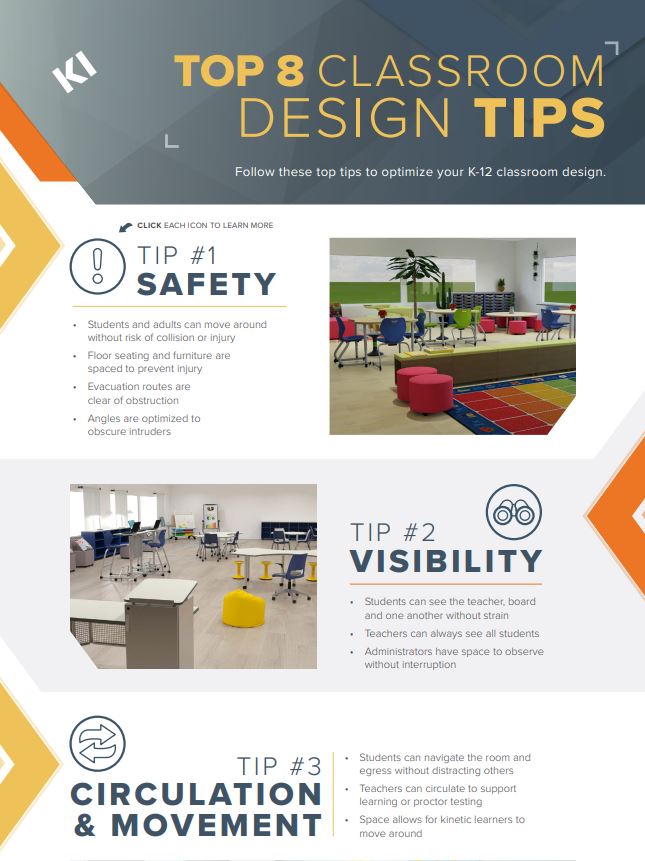Top Tips to Optimize Your Classroom Design

Design (and redesign) your classroom with these top eight tips to help you optimize the learning environment for your students.
When planning your classroom layout, it can be hard to know where to start. From your instructional style and lesson material to the various needs and personalities of each student, there are many different factors to consider.
If you’re looking to design a dynamic, collaborative and inclusive learning environment, follow these eight tips for revamping your space.
1. Put Safety First
Students and teachers should be able to move around the classroom without bumping into each other or getting hurt. Spacing out furniture, floor seating and other classroom elements can help avoid collisions or injuries.
To prepare your classroom for emergencies, keep a “triangle of safety” accessible where students can be obscured from the sightline of intruders and ensure evacuation routes are clear of any obstructions.
Vanderbilt University’s IRIS Center offers a useful guide with strategies and case studies on safe and effective classroom arrangements for different instructional formats.
2. Increase Visibility
Since learning takes a village—students, teachers and administrators are all involved in the process—it’s important to consider different viewpoints when designing your classroom.
Students should be able to see their teacher, fellow students and any areas where instruction is taking place without strain. Teachers should be able to have eyes on all students, and administrators should be able to stop in to observe without interrupting the class.
3. Champion Circulation & Movement
Classroom environments designed for ease of movement help kinetic learners move around and allow students to enter and exit without distracting others. According to the National Education Association, incorporating movement into learning improves students’ cognition, memory and recall as well.
Movement isn’t just for students either. When teachers move around the classroom, they have more opportunities to give students individual attention and keep them more engaged than if they stayed at the front of the classroom for the whole lesson.
4. Streamline Your Storage
To keep your classroom neat and tidy, ensure students have easy-to-access storage for personal items they use frequently, like coats, backpacks and school supplies. Longer-term storage can be kept separate and out of sight.
Of course, teachers will want separate storage for confidential and sensitive information and materials.
5. Support Social-Emotional Learning & Sensory Needs
Research shows that social and emotional learning has a positive impact on children, including strengthened interpersonal skills, improved academic performance, healthier self-image and reduced emotional distress.
To foster a classroom that supports social and emotional learning, you might include areas that meet different needs: spaces for students to interact with one another or engage in collaborative work, hang out during breaks from instruction, get away from sensory distractions or take a few minutes to themselves to “cool down.”
6. Advocate for Accessibility
Inclusive classroom designs indirectly teach students about accessibility and equity and help create a sense of belonging.
To embody that approach in your classroom, ensure students with different physical and behavioral accommodations have equitable space to navigate the room, be seated, and access physical classroom materials and supplies.
7. Prioritize Mobility & Flexibility
Flexibility is a term that’s thrown around a lot as it relates to classroom design, and for good reason.
A classroom arrangement that embodies mobility and flexibility can make a world of difference to your students by supporting different learning styles, allowing the class to easily move between group and individual work, and empowering students to own their space and learn on their own terms. When planning your classroom layout, also consider how flexibility can support testing accommodations.
8. Understand the Benefits of Biophilia
Biophilia recognizes the human desire to connect with nature. In the classroom, biophilic design elements can include visibility to the outdoors, natural light, plants and fresh air.
According to a report from the Association for Learning Environments, students in classrooms with biophilic design elements reported higher feelings of well-being, better concentration, lower stress and increased comfort. That environment can help students process and learn. One study found students in biophilic learning environments scored 3 times higher on math assessments than counterparts without them.
Design Your Best Learning Environment
Keeping these eight classroom design tips in mind will allow you to create a positive and well-rounded learning environment for your students.
Download our infographic for a quick review on how to keep your classroom layout on track for the remainder of the school year!
Subscribe
Stay up to date with the latest trends and more.









